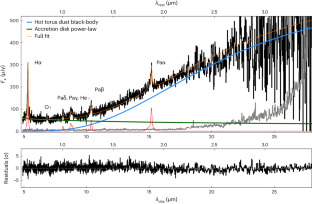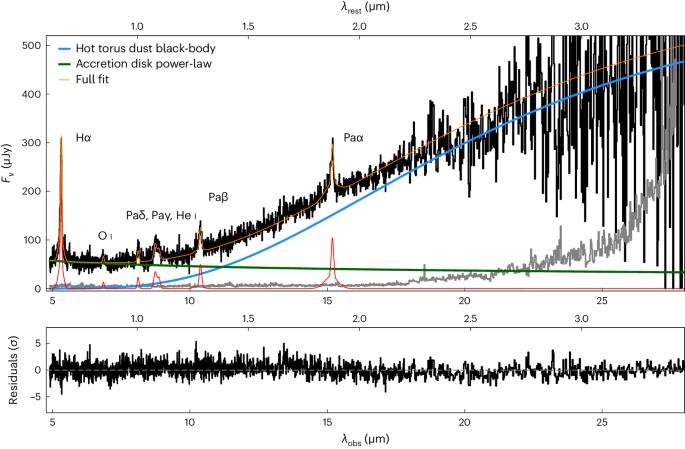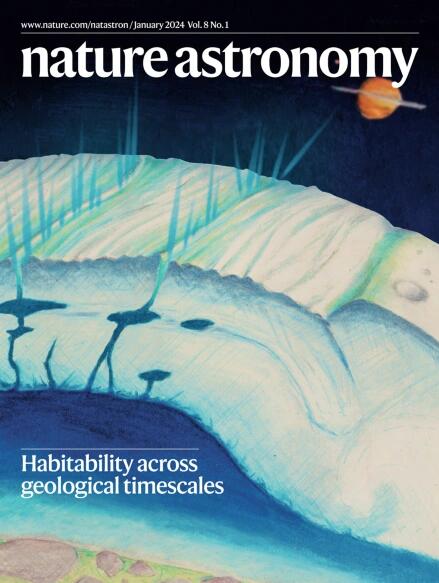A mature quasar at cosmic dawn revealed by JWST rest-frame infrared spectroscopy
IF 12.9
1区 物理与天体物理
Q1 ASTRONOMY & ASTROPHYSICS
引用次数: 0
Abstract
The rapid assembly of the first supermassive black holes is an enduring mystery. Until now, it was not known whether quasar ‘feeding’ structures (the ‘hot torus’) could assemble as fast as the smaller-scale quasar structures. We present JWST/MRS (rest-frame infrared) spectroscopic observations of the quasar J1120+0641 at z = 7.0848 (well within the epoch of reionization). The hot torus dust was clearly detected at λrest ≃ 1.3 μm, with a black-body temperature of $${T}_{{{{\rm{dust}}}}}=\text{1,413.5}_{-7.4}^{+5.7}$$ K, slightly elevated compared to similarly luminous quasars at lower redshifts. Importantly, the supermassive black hole mass of J1120+0641 based on the Hα line (accessible only with JWST), MBH = 1.52 ± 0.17 × 109 M⊙, is in good agreement with previous ground-based rest-frame ultraviolet Mg ii measurements. Comparing the ratios of the Hα, Paα and Paβ emission lines to predictions from a simple one-phase Cloudy model, we find that they are consistent with originating from a common broad-line region with physical parameters that are consistent with lower-redshift quasars. Together, this implies that J1120+0641’s accretion structures must have assembled very quickly, as they appear fully ‘mature’ less than 760 Myr after the Big Bang. A JWST/MIRI spectrum of an early quasar in the mid-infrared indicates that J1120+0641 had a mature feeding structure 760 Myr after the Big Bang. This finding suggests that supermassive black holes and their torii build up surprisingly quickly.


JWST 静止帧红外光谱仪揭示的宇宙黎明中的成熟类星体
第一个超大质量黑洞的快速组装是一个永恒之谜。直到现在,人们还不知道类星体的 "喂养 "结构("热环状")是否能像较小尺度的类星体结构一样快速组装。我们展示了 JWST/MRS(静帧红外)光谱对 z = 7.0848(远在再电离纪元之内)的类星体 J1120+0641 的观测结果。在 λrest ≃ 1.3 μm处清晰地探测到了热环尘,其黑体温度为({T}_{{{{\rm{dust}}}}}=text{1,413.5}_{-7.4}^{+5.7}\) K,与较低红移下类似亮度的类星体相比略有升高。重要的是,根据Hα线得出的J1120+0641的超大质量黑洞质量(只能通过JWST获得)MBH = 1.52 ± 0.17 × 109 M⊙,与之前的地基静帧紫外Mg ii测量结果非常吻合。我们将 Hα、Paα 和 Paβ 发射线的比率与简单的单相浊度模型的预测结果进行比较,发现它们都来自一个共同的宽线区域,其物理参数与低红移类星体一致。这意味着 J1120+0641 的吸积结构一定是在大爆炸后不到 760 Myr 就完全 "成熟 "了。
本文章由计算机程序翻译,如有差异,请以英文原文为准。
求助全文
约1分钟内获得全文
求助全文
来源期刊

Nature Astronomy
Physics and Astronomy-Astronomy and Astrophysics
CiteScore
19.50
自引率
2.80%
发文量
252
期刊介绍:
Nature Astronomy, the oldest science, has played a significant role in the history of Nature. Throughout the years, pioneering discoveries such as the first quasar, exoplanet, and understanding of spiral nebulae have been reported in the journal. With the introduction of Nature Astronomy, the field now receives expanded coverage, welcoming research in astronomy, astrophysics, and planetary science. The primary objective is to encourage closer collaboration among researchers in these related areas.
Similar to other journals under the Nature brand, Nature Astronomy boasts a devoted team of professional editors, ensuring fairness and rigorous peer-review processes. The journal maintains high standards in copy-editing and production, ensuring timely publication and editorial independence.
In addition to original research, Nature Astronomy publishes a wide range of content, including Comments, Reviews, News and Views, Features, and Correspondence. This diverse collection covers various disciplines within astronomy and includes contributions from a diverse range of voices.
 求助内容:
求助内容: 应助结果提醒方式:
应助结果提醒方式:


